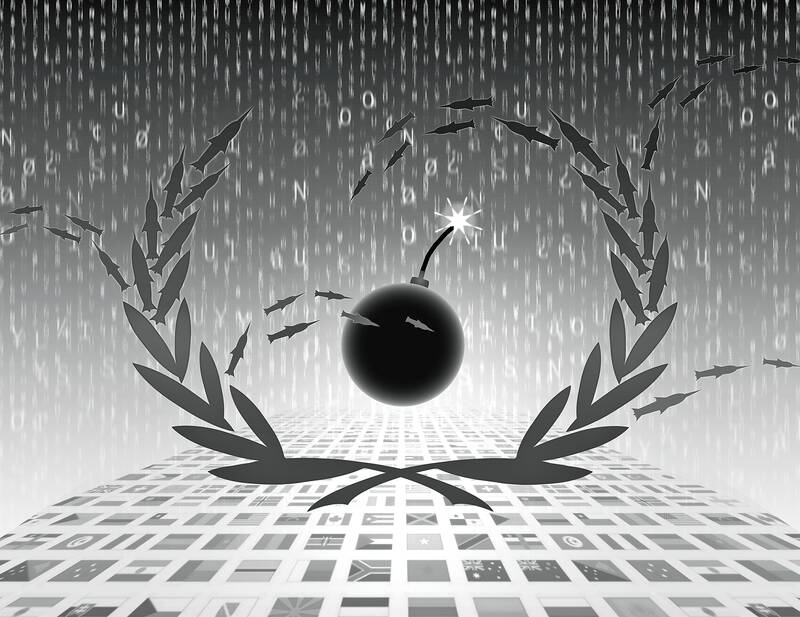World
Trump is right about World War III, but wrong about the analysis – Taipei Times

A third world war would actually be four or more wars being fought simultaneously, a proposal that would weigh heavy on Americans and US allies, not to mention the Pentagon’s budget
-
By Andreas Kluth
/ Bloomberg Opinion
Because much of what former US president Donald Trump says is unhinged and histrionic, it is tempting to dismiss all of it as bunk. Yet the potential future president has a populist knack for sounding alarums that resonate with the zeitgeist — for example, with growing anxiety about World War III and nuclear Armageddon.
“We’re a failing nation,” Trump ranted during his US presidential debate against US Vice President Kamala Harris in one particularly meandering answer (the one that also recycled urban myths about immigrants eating cats). “And what, what’s going on here, you’re going to end up in World War III, just to go into another subject.”
He brought it up twice more.
Illustration: Yusha
“We’re going to end up in a Third World War,” he closed. “And it will be a war like no other because of nuclear weapons.”
Oh dear. Could we please stick to speculating about feasting on felines as we contemplate the US and the world for the next four years? Unfortunately, we cannot, because even experts increasingly worry about a new specter of major and global war.
They do so for at least three reasons. One is the proliferation of hot regional wars, notably those in Ukraine and the Middle East, and the potential for more to break out, from in the Taiwan Strait and the South China Sea to the Korean Peninsula.
A second is that the direct or indirect aggressors in these conflicts — Russia, Iran, China and North Korea — increasingly behave like an “axis,” and could coordinate an attack against the US or its allies.
The third is indeed nuclear: Russia has roughly as many warheads as the US; China is racing for parity with both of them; North Korea is adding to its stash; and Iran is perilously close to building its own.
So the risks go beyond campaign hyperbole.
What should the US do? Prepare for World War III? If it is coming anyway, that would seem prudent, but doing so could turn it into a self-fulfilling prophecy. It would also be so ruinously expensive that the US might have to sacrifice its prosperity in the process.
Washington — the Pentagon, the US Congress, the think tanks and so forth — tends to swaddle such existential debates into language that normal people do not understand, lest we all freak out.
That means you have to pay extra attention to dry terms such as “force construct,” which refers to the government’s definition of what the US military should be able to do, and specifically how many wars it should be able to fight and win at the same time.
The government first started formulating explicit answers to that question, usually buried deep in Pentagon documents, just after the Cold War. At that time, Russia seemed less menacing and China was not yet a threat. The US was in effect a “hyper power” and explicitly adopted a force construct of being able to win two regional wars simultaneously — for example, one in the Middle East and one on the Korean Peninsula — while putting out smaller “brush fires” elsewhere (in the Balkans, say).
This two-war strategy remained doctrine for two decades. By the administration of former US president Barack Obama, the US was exhausted by the twin fiascos in Iraq and Afghanistan (where the opponents were not even “near-peers,” to use the lingo).
So the force construct was rewritten as winning one major war, while keeping other adversaries in check (without fighting them).
Wonks called the new construct one-war, 1+, 1.5 and other slyly ironic names (why not√3?). The shift fit a new era of more modest ambition abroad.
Trump and US President Joe Biden kept the strategy, with policy documents speaking of “defeating” one major power and “deterring” others.
Now the wind has shifted again. Academics are calling for a “three-theater” strategy to fight and win simultaneously in Europe, the Middle East and Asia.
The US Commission on the National Defense Strategy, appointed by the US Congress to review the Pentagon’s construct, goes further, demanding a military that can simultaneously defeat China, Russia, Iran and North Korea, while still crushing terrorist groups on the side.
By my count, that is a 4.5-war strategy.
The dilemma is that these options are all bad.
The obvious shortcoming of the one-war construct is that the US, whether it wants to or not, might have to fight in more than one “theater,” as in World War II — and if it only prepares for one, it could lose in the others.Worse, the one-war stance might actually dare enemies to become aggressive, if they think the US is already preoccupied on another front. Say the US is fighting China in the Taiwan Strait; North Korea might conclude that this is a good time to attack South Korea.
In general terms, the US cannot credibly claim to remain a global leader, with alliances and commitments in many places, if it is ready to fight in only one place.
One downside of the three (or 4.5) war construct is that the US cannot afford it. Washington reels from one budget crisis to another (next month’s budget deadline is nigh), and interest on the government debt already exceeds military spending.
Are Americans ready to double or triple defense expenditures to their share of GDP during the Cold War? Even the US Commission on the National Defense Strategy concedes that its construct would require much higher taxes and big cuts to Medicare and Social Security.
The even bigger drawback is that a three-war policy would set off a “spiral” known in international relations as a “security dilemma.”
Coined in 1950, that term refers to any situation in which one state (the US, in this case) feels threatened and arms, thereby scaring its adversaries (China, say) into arming faster, which then frightens the US even more, and so forth. That logic applies to conventional and to nuclear warfare. Not good.
The go-to escape hatch in these ever gloomier war games has become the word “allies.” As the US cannot deter or defeat all the world’s bad actors by itself, it needs help from its friends. So the European NATO partners must step up in defending against Russia; and Japan, Australia and the other Asian allies need to get ready to fight China.
All these armies, navies, air and space forces must work together, supplying one another with the interoperable weapons (so everybody can load and repair them), and fighting with one strategy.
This is not a modest proposal. It would require an entirely new worldview, over stiff domestic opposition, in capitals from Berlin to Canberra and Tokyo. The allies have long assumed that the US would come to their aid, not they to the US’. The idea also assumes unprecedented upheaval in Washington’s Byzantine defense-procurement and planning bureaucracy, which gums up cooperation with foreign partners at every step.
Merely broaching the subject of upgrading the US’ relationship with its allies should disqualify Trump from office, based on what we know about him. He does not see foreign partners as brothers-in-arms with whom to keep the peace or win the war. With his petty transactional mind, he instead treats them as a used-car salesman greets walk-ins.
That said, if Trump does not have answers, neither does Harris, at least so far. The scariest thing about last week’s debate might be that in his febrile bouts of logorrhea, Trump inadvertently brought up a risk that all of us need to discuss, and not just in the US.
Andreas Kluth is a Bloomberg Opinion columnist covering US diplomacy, national security and geopolitics. Previously, he was editor-in-chief of Handelsblatt Global and a writer for The Economist.
Comments will be moderated. Keep comments relevant to the article. Remarks containing abusive and obscene language, personal attacks of any kind or promotion will be removed and the user banned. Final decision will be at the discretion of the Taipei Times.










